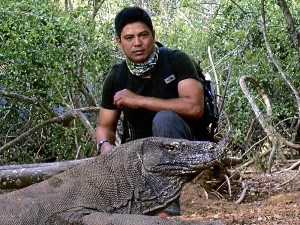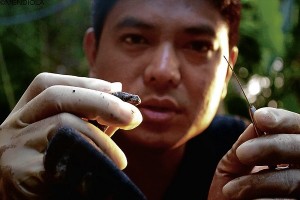
I’m sitting at a coffee shop table with Dr. Nielsen Donato, renowned veterinarian and, for the past year-and-a-half, co-host (with fellow vet Dr. Ferds Recio) of the environmental show “Born To Be Wild,” which airs Wednesday nights at 11:30 on GMA 7 (with a spin-off, “Born Impact,” Sundays at 9:30 p.m.). And his phone won’t stop ringing.
In recent months, the show, with its dramatic footage and Nat Geo-esque feel, has developed a cult following, thanks in large part to the two able and good-looking hosts who think nothing of handling snakes, swimming with sharks and wrestling crocodiles.
Since I’ve known the 45-year-old Nielsen (full disclosure: He successfully fixed my late dog Banana’s luxating kneecap years ago), I know he has, indeed, wrestled crocs, come within chomping distance of a Komodo dragon, and almost gotten mauled by a tiger.
Today, though, he’s on his phone, excited, because he’s set to do dental work—on a hamster. “Of course I still love doing stuff like this,” he exclaims.
Although he’s out shooting in the field about a week every month, Nielsen says, “I’d like to correct the idea some people have that I don’t practice anymore. I still enjoy being a vet to companion animals like dogs and cats.”
Our interview is interrupted half a dozen times by calls he must take, dealing with veterinary cases from the aforementioned hamster to dog surgery.
“It’s amazing how the Filipino pet owner has changed. In the case of the hamster, they would pay P250 for the animal, but wouldn’t think twice of paying P2,500 for a medical procedure. Before, they would just replace the animal.”
Supportive family
With Vets in Practice (VIP), the successful animal hospital chain Nielsen co-owns with partners doctors Nick and Marga Carpio and Dr. Mike Velhagen, opening its fifth branch soon, Nielsen is finally able to indulge his passion for wildlife advocacy through the show.
“Good thing my partners allowed me, and my family has been so supportive,” he says.

Family is wife Carol and children Cedric, 18, and a college freshman, and Nina, 9, in third grade. In fact, Nielsen recounts, during a recent episode filmed in South Cotabato to search for a local creature known among the B’laan tribe as “mal”—and which turned out to be none other than a tarsier, originally thought to be endemic only to Bohol and Samar—he also managed to save a trapped civet cat, thanks to a survival kit packed for him by Carol and Nina.
“On social networks, you’d be surprised how many people react to an animal rescue story. There’s really so much more awareness now,” he notes.
The truth is, Nielsen, long a favorite of TV shows as a guest expert on both domestic and exotic animals, was invited to host “Born” when the show started five years ago. He had to decline at the time, as VIP was still growing.
“I felt bad that I had to say no, though, because this was something I’ve always wanted to do.”
As part of a group called the Feather Friends Foundation, Nielsen, who has a soft spot for birds, would use his own money on community outreach programs. He also opened the Laguna Wildlife Park and Rescue Center on family property in Pansol, where he keeps dozens of rescued animals.
Advantage
Being a vet, he says, is an advantage when hosting, “because we can do what needs to be done on site”—an ace on a show that’s unscripted and full of surprises, like when he was searching for Bryde’s whales in Pamilacan, Bohol, and was treated to the magnificent spectacle of a blue whale fluking, or showing its tail for the camera to capture.
“In the first few years of ‘Born,’ they were always featuring animals in zoos and cages. Now, mas magastos, because we’re shooting animals in the wild. You can’t call ahead and book them, or say ‘Hoy, hulihin n’yo!’ The show had its growing pains, when it suffered criticism from the scientific community, but now our researchers really work hard and are well aware of the ethics.”

To guard against wildlife poachers, the show never reveals the exact location of a shoot, unless, like in the case of the mal, the community itself asks for exposure to develop local ecotourism.
To be sure, Nielsen had to work at being a good host—including joining a hosting workshop.
“Dati, all I could say was,’’ ‘Amazing!’” he says with a chuckle. “Now, I always have to ask, what does this information mean to the average Filipino? I can’t just say me, me, me all the time. Like when we featured the water snakes of Taal—ano ngayon? We have to connect people to wildlife, like explaining that water snakes help fertilize the soil at the bottom of a lake, for example, so there is good vegetation for fish.”
Fortunately, the worst mishap he was ever in was during one of the show’s regular free clinics, this time in Laguna, when he fell off a horse while chasing after a runaway carabao. He cut his hand badly on a sharp piece of wood, and had to keep talking on cam even as they stitched him up.
Wildlife issues
Nielsen knows where he stands on several wildlife issues.
“I think the trend is starting to change,” he says of zoos and theme parks. “Their front is education, but I think that only sends the wrong signal. It makes people think, ‘I want to have that, an elephant in my backyard.’ We grew up in that kind of environment; I also collected wildlife once. It was going out into the wild that changed my view—mahirap, papawisan ka, uulanan ka, but when you find it, it’s all worth it. The same goes for these trained marine animals. Nandiyan na ’yan, it will be difficult to release them because they will be disadvantaged, but sana hindi na madagdagan.”
On the embattled Mali, the aging elephant in Manila Zoo that many animal welfare groups are lobbying to transfer to a sanctuary, Nielsen says, “If there was only a safe way to bring her back, I would go for that. Don’t you want her to feel the grass under her feet, or be with a herd? But only if all the parties involved won’t blame each other if something goes wrong. Unfortunately, that ‘safe’ way is very tricky.
“I’ve done just one story on Chiang Mai elephants, and they were trained by mahouts, in a very cruel way. Mali is raw; can anybody touch her cuticles, for example? I don’t know how much time you will need to train her without hurting her. How will you get her into a trailer? You need to sedate her, and only an experienced pachyderm vet can do that. I’m used to old dogs, hindi ko aatrasan ang 16-year-old na aso, but in this case, sino ang mananagot? Maybe that’s the reason why up to now, no decision has been made.”
Then there was Lolong, the record-breaking Agusan crocodile, which he visited.
“When I first learned it had been caught, my mind told me that this croc shouldn’t be in captivity,” he recalls. “I really wasn’t surprised when he died. A wild croc needs so much space.”
When the town mayor called to inform Nielsen of Lolong’s death and hinted at hunting for the animal’s alleged mate, Nielsen suggested that, if they ever found it, they invite researchers to attach a transmitter to the animal and release it, instead of keeping it captive again.
Addicting
So far, Nielsen describes the adventure of hosting an environmental show as “addicting. There’s always something exciting to look forward to.”
One of the show’s goals, he says, is “to make the ordinary citizen realize that, oops, bawal na ’yan—to educate them and get them concerned. There’s still a lack of community involvement, although there’s a big improvement now. Before, nobody would say anything if there was poaching or abuse.”
What to do this summer, then, when people encounter animals on their trips and outings?
“Enjoy them! Our cameras are so powerful. When we post pictures of animals on social media, we get so many ‘likes.’ Get your satisfaction from just seeing them. It’s so beautiful to see them in the wild.”









































